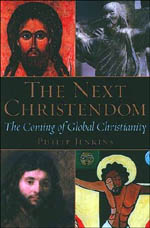 (Reprinted with permission from The National Review, written by Sarah E. Hinlicky.)
(Reprinted with permission from The National Review, written by Sarah E. Hinlicky.)
Southern Exposure
The quasi-apocalyptic warnings are all too familiar by now. Christianity is on the way out, and the West’s stranglehold on religion is going the way of the dodo. If the old faith of the oppressors has any hope at all, opine the advocates of obliterating “reform,” it must change or die; meanwhile, the fearsome forces of Islam range unchecked across the globe, as the crescent surely and irrevocably replaces the cross. The religious landscape of this new century holds little hope for the followers of Jesus.
All of these deadly serious predictions are familiar; they also, however, happen to be laughably untrue. At present count, there are two billion Christians in the world. By the year 2050, there will be three billion, outnumbering Muslims three to two. Christianity is anything but moribund, so whence the rumors of its imminent, whimpering death?
In The Next Christendom: The Coming of Global Christianity, Philip Jenkins, professor of history and religious studies at Penn State, makes the sensible case that Christianity is indeed growing quickly, just not in its old haunts—Europe and North America
—and not in ways particularly attractive to the mainstream media. In the first place, Christianity’s center of gravity is shifting south: before the end of this century we can well expect Africa, Asia, and Latin America to be the home of the most vibrant and populous Christian nations on earth. Already fast approaching Europe’s 560 million Christians, Latin America is home to 480 million, Africa to 360 million, Asia to 313 million—and all of these are notably larger contingents than North America’s mere 260 million.
Perhaps even more striking is the kind of people who are attracted to Christianity in the Southern Hemisphere. On the whole, they are not much like their northern counterparts: They are overwhelmingly poor, displaced from rural villages into overcrowded cities in search of work. They are morally conservative, often to the point of being puritanical, and theologically orthodox. They adhere strictly to the word of Scripture, which commands their loyalty far more than state or society; and they expect supernatural intervention in their daily lives, be it in the form of faith healing or ecstatic prophecy. They tend to be Roman Catholic (frequently charismatic) or Pentecostal.
Northern conservatives laud the traditional morality, in particular the traditional sexual morality, found in the South, and discover therein the means to defend unpopular decisions at home. Northern liberals, on the other hand, uphold the South’s tendencies towards liberation theology in order to plead for social reform and make prophetic critiques of capitalist excesses.
The churches of the South do, in fact, exhibit the qualities Northerners ascribe to them; but Jenkins argues that adopting the southern churches for northern rhetorical purposes is a dead end, because what the North has to say about Christianity is not going to matter much as the years pass.
The southern churches have ceased to be the transplants of colonial good will they still were at the beginning of the twentieth century. They have become indigenous, with their own clergy, prophets, traditions, and theologies; and so it is entirely reasonable to expect that the heart, soul, and mind of the Christian faith will very soon be found not in Europe, but south of the Equator.
In many ways, Jenkins demonstrates, the growth of the church in the Southern Hemisphere now shows striking parallels to its growth in Europe after Constantine. Today’s pressing question—how to deal with enemies who make war in the name of Islam—also has a precedent in that period. But though the religious and cultural changes in the post-Constantinian period were often the object of violent struggle, we tend to view the outcome as basically good; and there is little reason to doubt that there will be a similarly positive result in the South.
Jenkins’s meticulously researched work should serve, however, as a wakeup call for northern Christians. The North is steadily losing its population and grip on the faith, to such an extent that it is no longer surprising when missionaries come from the South to their secularized elder brothers up North.
Whatever one’s personal hopes for the future of the church, one basic fact remains unchanged: “Christianity exercises an overwhelming global appeal, which shows not the slightest sign of waning.”
Appetizer
Christianity should enjoy a worldwide boom in the new century, but the vast majority of believers will be neither white nor Euro-American. . . . In the year 2025, Africa and Latin American would be in competition for the title of most Christian continent. . . . By 2050, only about one-fifth of the world’s three billion Christians will be non-Hispanic whites.
—The Next Christendom



























